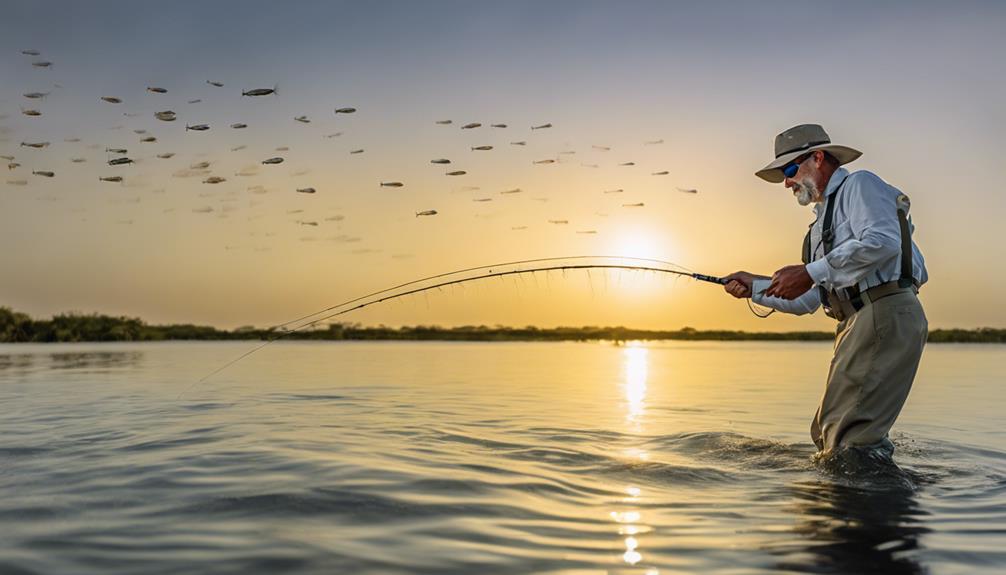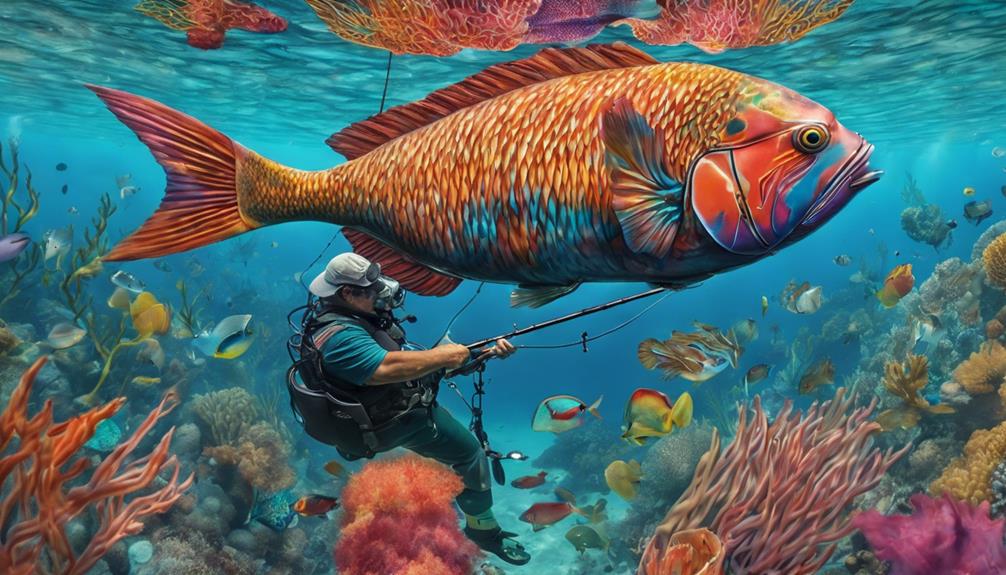As you cast your line into the water, have you ever wondered if there are secrets to catching different species of fish with a fly? Each type of fish has its own preferences and behaviors, requiring specific techniques to lure them in.
Understanding these nuances can significantly improve your success rate on the water. From the elusive trout to the powerful tarpon, mastering species-specific fly-fishing techniques can be the key to unlocking a whole new level of angling expertise.
Trout Fly-Fishing Techniques
Mastering the art of casting is essential for successful trout fly-fishing. When it comes to trout, a variety of techniques can be employed to maximize your chances of a great catch. Nymphing strategies are particularly effective when trout are feeding underwater. By presenting nymphs that imitate aquatic insects in a natural manner, you can entice even the most cautious trout.
Additionally, dry fly tactics are crucial for targeting trout that are actively rising to the surface. Matching the hatch and delicately presenting your dry fly can lead to exhilarating takes from these selective feeders.
Streamer presentations offer a different approach, mimicking small fish or other prey to trigger aggressive strikes from larger trout. By mastering the art of streamer fishing, you can target trophy trout in various water conditions.
Euro nymphing techniques, on the other hand, involve using heavily weighted nymphs on long leaders to get your flies down quickly to where the fish are holding. This method allows for precise presentations in fast-moving currents, increasing your chances of enticing trout in challenging environments.
Bass Fly-Fishing Techniques
When transitioning from targeting trout to pursuing bass, adapting your fly-fishing techniques is crucial for success in landing these powerful freshwater predators. Bass are known for their aggressive nature, so matching the hatch may not be as critical as enticing their predatory instincts. Two main techniques for bass fly-fishing are topwater and streamer fishing.
Topwater bass fishing involves using flies that float on the surface of the water, imitating insects, frogs, or other creatures that bass prey upon. To effectively fish topwater flies for bass, focus on early mornings or late evenings when bass are most active near the surface. Use poppers, gurglers, or deer hair bugs to create commotion and attract bass to strike.
On the other hand, streamer bass fishing involves using flies that mimic baitfish or other larger prey. This technique is effective for targeting bigger bass that are looking for a substantial meal. Cast streamer flies along the banks, near structures, or in deeper waters where bass may be lurking. Popular streamer patterns for bass include woolly buggers, clouser minnows, and deceivers.
Both topwater and streamer bass fishing techniques can be highly rewarding when targeting these powerful freshwater predators. Experiment with different patterns, sizes, and retrieves to find what works best in your local bass fishing waters.
Salmon Fly-Fishing Techniques
Utilizing specialized flies and adapting your casting technique can enhance your success in salmon fly-fishing. When it comes to fly selection for salmon, it's crucial to match the hatch and consider the water conditions. Opt for larger, more vibrant flies that mimic the natural prey of salmon in the specific river you're fishing. Experiment with different patterns and sizes to see what works best.
In terms of casting techniques, mastering the art of the double haul can significantly improve your chances of hooking a salmon. This technique allows you to generate more line speed and power, enabling you to cast further and more accurately. Practice your timing and coordination to perfect the double haul and make your casts more efficient.
River conditions and weather patterns play a vital role in salmon fly-fishing. Keep an eye on water levels, clarity, and temperature to adjust your approach accordingly. Salmon are more active in certain weather conditions, so be prepared to adapt your strategy based on the forecast. Remember that patience and persistence are key when targeting these elusive fish.
Pike Fly-Fishing Techniques
To enhance your success in pike fly-fishing, adapt your fly selection and casting technique to suit the predatory nature of these aggressive freshwater predators. Pike are known for their voracious appetite and lightning-fast strikes, so choosing the right flies and presentation is crucial. When it comes to pike fly tying strategies, opt for large, bulky flies that mimic their preferred prey such as small fish, frogs, or even small mammals. Bright colors and flashy materials can also help attract their attention in the water.
Understanding the unique pike habitats is also essential for a successful fishing trip. Pike are often found in weedy areas, near submerged vegetation, or along the edges of drop-offs. Targeting these specific locations can increase your chances of hooking a pike. When casting, make sure to deliver your fly close to these areas and retrieve it with erratic movements to mimic a wounded baitfish, triggering a predatory response from the pike.
Incorporating these pike fly-fishing techniques into your approach can lead to more hook-ups and thrilling battles with these apex predators. By fine-tuning your fly selection, mastering your casting technique, and honing in on unique pike habitats, you'll be well on your way to a successful pike fly-fishing adventure.
Carp Fly-Fishing Techniques
Enhance your carp fly-fishing success by adapting your fly selection and casting technique to match the feeding behavior of these bottom-feeding freshwater fish. When targeting carp, it's crucial to employ specific tactics tailored to their unique habits. Here are some key strategies to elevate your carp fly-fishing game:
- Carp Fly Fishing Stealth Tactics: Carp are known for their wariness, so approach with caution. Wear muted clothing, avoid sudden movements, and keep a low profile to prevent spooking these sensitive fish.
- Effective Bait Choices: Carp have diverse feeding preferences, making it essential to experiment with various bait options. Corn, bread, and boilies are popular choices that can entice carp to strike your fly.
- Unique Carp Fly Fishing Locations: Look for shallow, weedy areas with slow-moving or still waters. Carp tend to frequent these environments, making them prime spots for a successful fishing expedition.
- Optimal Casting Techniques: When casting to carp, accuracy is key. Practice presenting your fly gently and precisely near the fish without causing disturbances. Mastering the art of delicate casts can significantly increase your chances of a successful catch.
Bonefish Fly-Fishing Techniques
When shifting your focus to bonefish fly-fishing techniques, adapt your approach to suit the swift and elusive nature of these saltwater species. Bonefish are known for their skittish behavior, requiring a stealthy and strategic approach. Understanding tide conditions is crucial; bonefish often feed actively during incoming tides, so plan your fishing trips accordingly.
In terms of casting distance, bonefish are typically found in shallow waters, so precision is key. Aim for accurate casts within the 30 to 50-foot range to avoid spooking these sensitive fish. When it comes to fly selection, opt for patterns that mimic the natural prey of bonefish such as shrimp or small crabs. A well-presented fly can make all the difference in enticing a bonefish to strike.
Additionally, the retrieve speed plays a significant role in attracting bonefish. A slow and steady retrieve often works best, imitating the movement of a natural prey item. Keep an eye on the behavior of the fish; if they seem hesitant, try varying your retrieve speed to entice a strike.
Tarpon Fly-Fishing Techniques

For successful tarpon fly-fishing techniques, focus on mastering the art of presentation and precision in your approach. When targeting these powerful silver kings, attention to detail can make all the difference in landing that trophy catch. Here are some key tips to enhance your tarpon fly-fishing experience:
- Tarpon Fly Fishing Knots: Utilize strong and reliable knots such as the non-slip loop knot or the improved clinch knot to ensure your flies stay secure when battling these hard-fighting fish.
- Casting Techniques: Practice your distance casting and accuracy to target tarpon effectively, especially in challenging conditions like windy days or around structure.
- Tarpon Fly Fishing Gear: Invest in quality gear such as a sturdy 10-12 weight fly rod, a reliable saltwater fly reel with a strong drag system, and heavy-duty leaders to handle the brute strength of tarpon.
- Tarpon Fly Fishing Locations: Research prime tarpon fishing locations like the Florida Keys, Belize, or Costa Rica, where these majestic fish migrate seasonally, providing ample opportunities for thrilling fly-fishing encounters.
Steelhead Fly-Fishing Techniques
To excel in steelhead fly-fishing, focus on mastering the subtleties of presentation and precision in your approach. These elusive fish demand skill and finesse to hook successfully. When it comes to steelhead presentation tactics, consider the water conditions and the behavior of the fish. Steelhead are known for their wariness, so a delicate presentation is key. Choose the right fly based on the water clarity and weather conditions to increase your chances of a successful catch.
Nymphing strategies can be highly effective when targeting steelhead. Look for slower-moving pockets of water where steelhead are likely to hold, and adjust your nymphing depth accordingly. Pay attention to the subtle movements of your indicator to detect strikes, as steelhead bites can be quite gentle. By honing your water reading skills, you can identify prime steelhead holding spots and increase your chances of a hookup.
In steelhead fly-fishing, success lies in the details. Pay close attention to your fly selection, presentation techniques, and reading the water to outsmart these elusive fish. With practice and patience, you can develop the finesse needed to hook steelhead consistently.
Frequently Asked Questions
Can Fly-Fishing Techniques Be Adapted for Catching Other Types of Fish, Such as Catfish or Walleye?
When trying to catch other types of fish like catfish or walleye, you can adapt fly-fishing techniques. Bait selection and techniques are crucial. Focus on using bait that these fish are attracted to and adjust your casting and retrieval methods accordingly.
Consider the location and the type of water you're fishing in. Make sure your equipment, such as rods and lines, is suitable for the size and behavior of the fish you're targeting.
Are There Specific Fly-Fishing Techniques That Work Best in Different Types of Weather Conditions?
When fishing on a rainy day, it's crucial to adjust your fly-fishing techniques. Look for sheltered spots where fish may be hiding from the downpour.
Use darker-colored flies that mimic drowned insects. In windy conditions, opt for heavier flies that can cut through the gusts.
Cast at an angle to the wind to prevent tangles and achieve better accuracy. Adapting your approach to the weather conditions can improve your chances of a successful catch.
How Important Is It to Match the Hatch When Fly-Fishing for Various Species of Fish?
When fly-fishing for different fish species, matching the hatch is crucial. Pay attention to water temperature as it influences insect activity.
Study entomology to understand the insects fish are feeding on. Choose flies that mimic these insects for successful fishing.
Use specific presentation techniques to attract fish in different conditions. Take time to observe the surroundings and adapt your fly selection to match what the fish are feeding on.
What Are Some Commonly Overlooked Factors That Can Affect the Success of Fly-Fishing for Specific Species?
When fly-fishing for specific species, remember that success hinges on more than just matching the hatch. Consider overlooked factors like water temperature and habitat preferences. These elements can greatly impact your fishing experience.
Pay attention to fly selection and presentation techniques tailored to each species you target. By addressing these often disregarded aspects, you can enhance your chances of a successful day on the water.
Are There Any Emerging Trends or Advancements in Fly-Fishing Gear That Can Enhance the Experience of Targeting Different Types of Fish?
When looking at the latest trends in fly-fishing gear, you'll find that there are some exciting innovations that can really level up your experience when targeting different types of fish.
From specialized equipment designed for targeted angling to species-specific techniques, advancements in gear have made it easier and more successful to catch specific fish.
Conclusion
Now that you've learned about species-specific fly-fishing techniques for trout, bass, salmon, pike, carp, bonefish, tarpon, and steelhead, you can fine-tune your skills to catch more fish.
Remember to adapt your approach based on the species you're targeting and the environment you're fishing in.
Keep practicing and experimenting with different techniques to become a more successful fly angler.
Good luck out on the water!



